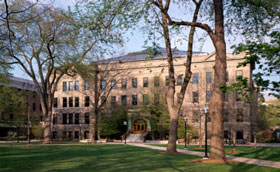Visit www.css.snre.umich.edu/facts
Since the early 1990s, Peter Wege has been actively involved with the School of Natural Resources and the Environment at the University of Michigan where he went to school. In 1991, when the SNR & E won the Environmental Protection Agency’s national competition to house the country’s first National Pollution Prevention Center, Michigan had an important requirement.
A major aspect of the EPA grant was that the NPP Center would appoint an External Advisory Board made up of people outside the academic campus who were leaders in the private sector. Having heard of Peter M. Wege’s environmental influence on Steelcase Inc., where he was an executive, Dr. Jonathan Bulkley and his younger assistant Dr. Greg Keoleian, asked him to head up the first External Advisory Board.
It was the beginning of a mutual admiration society between Grand Rapids and Ann Arbor that led to several collaborative projects, including the annual Wege Lectures given on the Michigan campus. It was also the beginning of a deep friendship among the three men.
In the late 1990s, the environmental thrust moved beyond preventing pollution to promoting sustainability. The National Pollution Prevention Center evolved into the Center for Sustainable Systems, with Peter Wege continuing to chair the External Advisory Board. Among many definitions of sustainability, one of the clearest summaries is that we must meet the needs of the present without compromising the ability of future generations to meet their own needs.
One of the CSS’s important callings is to educate people beyond the academic world about sustainability. Their new web site is an important medium to achieving that end. The CSS Fact Sheets are one-page snapshots on the environmental impacts of everything from personal transportation to residential buildings to how our country supplies and distributes water.
While the information in these Fact Sheets is often unnerving, they do offer various solutions and alternatives. The Fact Sheets are a great resource for mainstream Americans not familiar with the environmental lingo as they are written in clear English with lots of graphs, charts, and drawings to help viewers visualize the numbers.
Pictured above is the University of Michigan’s Dana Building housing the School of Natural Resources and Environment. As the Dana approached its 100th birthday in the 1990s, the dilapidated classroom building faced demolition. But SNR & E Professors Jonathan Bulkley and Greg Keoleian convinced the University to instead restore Dana as an example of green rebuilding.
Peter Wege was involved from the beginning in what became known as “The Greening of Dana.” The Dana restoration gained national attention as a hands-on clinic for SNR & E students in environmental reconstruction. In 2005, the Dana Building received a gold rating from the United States Green Building Council making it the greenest academic building in the state of Michigan.


